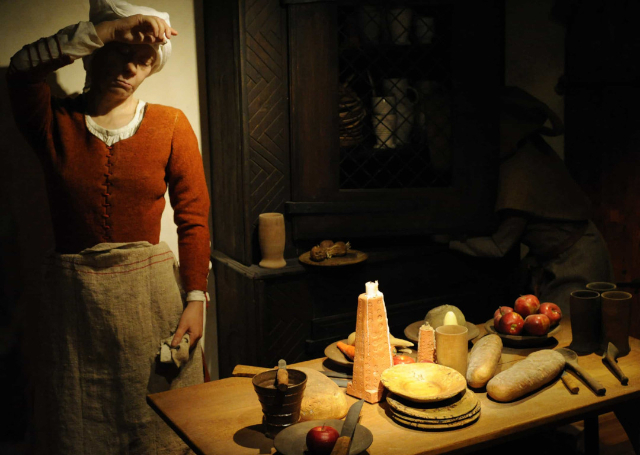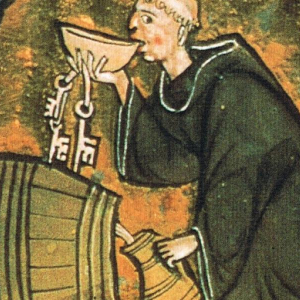I was intrigued by a lengthy, detailed post I found recently, that talks about the average diet in Medieval times. And I want to share with you some of the revelations I found so entrancing. Wait until you hear how much bread the average person ate per day!
 A typical ‘hearty’ Medieval supper: Often served after a 12-hour
A typical ‘hearty’ Medieval supper: Often served after a 12-hour
day toiling in the fields or by the hearth…
Not a great time to be alive
English philosopher Tomas Hobbes is credited with coining the now-famous description of Medieval life: “Nasty, brutish, and short.”
It was actually part of a longer description, of life ‘outside of society’, in which we would all reveal ourselves as thieving, murderous creatures, who would do anything to survive. Only by agreeing to a ‘social contract’, to give up some of these ‘freedoms’ could we enjoy a safer, healthier, longer life.
Scholar Nigel Warburton wrote: “You might argue, only some people are that selfish. Hobbes disagreed. He thought that at heart we all are, and that it is only the rule of law and the threat of punishment that keep us in check.”
Back to reality
Wow! Am I glad we’re only interested in the menu, today…
Nevertheless, that description of what Hobbes dubbed a ‘sovereign’ existence is all too relevant to the Middle Ages. The masses were almost indescribably poor. Many were tenant farmers or indentured servants. Most were illiterate. All except the top 1 percent or so did business in barter, rather than exchanging money. Disease ran rampant. According to a Letter To The Editor in the 2005 issue The International Journal of Epidemiology, of the average lifespan in Europe in the middle ages, “reached 33 years.”
‘What’s for dinner?’
For a start, the average family didn’t eat breakfast. The all-powerful Church decreed that eating breakfast was tantamount to committing the Cardinal Sin of Gluttony. Today, we know better. In fact, we’ve come to accept that breakfast is the most important meal of the day.
The first real meal of the day was ‘lunch’ of a sort. The post I read describes it as a ‘light dinner at midday’. Supper – a much heartier meal – was eaten in the evening, after the day’s work was done. And the medieval regimen also included something called ‘reresopa’. That translates in modern English literally as ‘rear supper’. It came late at night, some time after the main supper. Reminds me of Tolkien’s concept of Second Breakfast, in the Lord of the Rings universe…
The staff of life
Bread has long been considered the most basic of foods, and an essential in our diets. Today, we define that need more finely in nutritional terms as an official recommendation that, ideally, a quarter of our daily food intake should be comprised of whole grains.
But in Medieval times, bread was just about all the average family could afford. It’s estimated that the average adult ate 2-3 lb. / 1 – 1.5 kg of bread every day. That’s equivalent to and entire loaf of today’ white sliced bread. Bread was made from a variety of grains, including wheat, rye, oats and barley. Porridges made from the same grains were also common.
Quaff an ale
Most folks either lived far enough outside the cities to have clean spring water available, or drank beer (see photo, top of page). Even then, it was known that dirty water spread disease. So the custom evolved of folks consuming mildly alcoholic beverages instead. They didn’t know it, but they were indulging in an early, unofficial form of antibiotic! The drink, commonly known as ‘ale’ was made from minimally-fermented barley, and was consumed by all ages.
Vegetables saved the day
Veggies – primarily root vegetables – may have saved he day for Medieval diners. They often ate vegetarian soups and stews containing whatever veggies they could grow themselves or barter from neighbours. A combination of potatoes, carrots, parsnips and/or turnips was basic. You night an onion, of you were lucky. Beans and peas were also relatively abundant.
We now know that veggies bring us a host of important nutrients. Today, the official nutrition guides of all developed countries say we should fill half our dinner plate with a variety of veggies to maintain prime health and well being. Most folks in the Middle Ages got their vital nutrients more or less by accident.
Meat was for the rich
Meat was a rarity on the average family’s table. It was only mandated at feast days, and then might consist solely of scraps from the tables of the wealthy 1 percent. A complete protein was generally delivered in the now-familiar combination of grains and legumes. The poor folks didn’t know about the science behind protein at the time. They just ate what they could get their hands on. And it generally turned out to be nutritionally appropriate.
My take
If you read between the lines, the foregoing nuggets add up to a startling conclusion: The average person’s diet in the ‘nasty, brutish’ Middle Ages was more heart healthy than the average person’s today! Les likely to incite cancer or diabetes, too.
Less meat. More veggies. More plant-based proteins. Exactly where we’re all headed, just to survive the looming climate crisis, by evolving our eating habits into a more sustainable model…
~ Maggie J.

